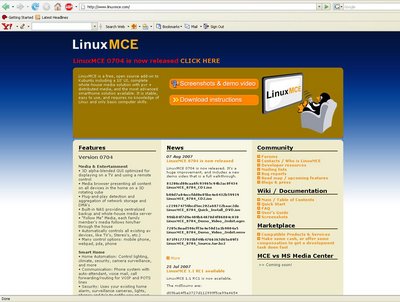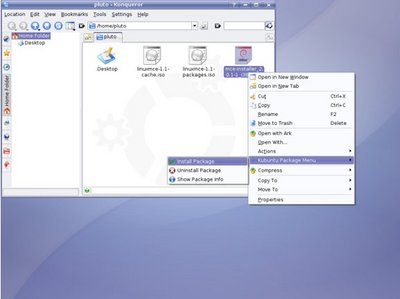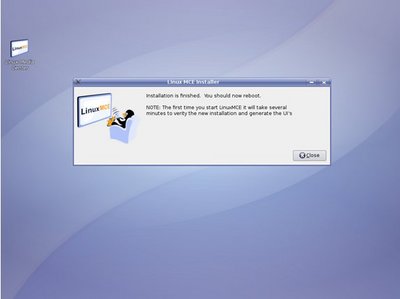Installation Guide
After installation please visit this page and fill in any information you have about the installation process. This will aid the developers in fixing any faults.
If you want to install LinuxMCE using the DVD check these steps DVD Installation
Kubuntu 7.10==(edited 19/03/2008)
Steps for installing Linux MCE on an Kubuntu 7.10 (Gutsy Gibbon) system :
Previous Kubuntu 7.10 installation
Preliminary note: This article has been modified to reflect installation with Kubuntu 7.10 (Gutsy) whereas this article originally was based on 7.04 (Feisty).
You can install LinuxMCE on an existing internet connected installation of Kubuntu. LinuxMCE will only work with Kubuntu version 7.10.
If you have made significant changes to a the original default Kubuntu install then you may have issues installing LinuxMCE and you may loose some of your configuration files. Currently it has only been tested on default installation via the Live CD.
New installation
If you don't have an Kubuntu system already installed please follow these generic steps:
- Take an Kubuntu 7.10 Live CD and boot from it.
- LinuxMCE (2 CD version) works with Kubuntu 7.10 which is no longer available on their website. Use the link above.
- Choose 'Start or install Kubuntu'
- When Kubuntu's desktop appears, click on 'Install'
- A short wizard will start and guide you; Select the language and press 'forward'
- Choose your timezone and press 'forward'
- Select the keyboard layout
- Choose desktop name, a user name and a password
- Select the partitioning options for your disk: erase the entire disk or just manually edit the options.
- Ready to install.
- Reboot the system and remove the Live CD
LinuxMCE
Downloading LinuxMCE
From within the Kubuntu 7.10 desktop, open Firefox (the orange and blue icon at the top), and go to www.linuxmce.com and select 'Download Instructions' to download the Linux MCE CD`s or the DVD on your machine. Or just use this direct link
Installing mce-installer from KDE Menu
Once you have downloaded the packages, proceed with the installation. First, you have to install mce-installer, which is the software that will guide you through the installation. Right-click on it, go to Kubuntu Package Menu -> Install Package.
Installing mce-installer from command prompt
Alternatively, you can install the mce-installer from a command prompt without the need to burn the ISOs as follows:
cd /directory/where/the/downloaded/iso/files/are/ mkdir -pv mnt sudo mount LinuxMCE_0704_CD1.iso mnt/ -o loop sudo dpkg -i mnt/mce-installer_2.0.1-1_i386.deb sudo umount mnt rmdir -v mnt
Install LinuxMCE
The installer will have put an "Install LinuxMCE" icon on your desktop. Click it to start the installation process. A window will appear saying that you will be notified when updates are available.
Choosing type of Core
After this you have to choose if you want a dedicated core or a hybrid (click hereto find out the difference between a core and a hybrid), and then click on "Forward" button.
Choosing Video Card
- Only for Nvidia cards - LinuxMCE will detect that you are using a nVidia Card, but you are not using the proprietary video driver. Only that driver works well with LinuxMCE and nvidia cards and it will ask you it you want to switch to it now.
Network Configuration
The next screen will ask you want to keep your current network configuration or if you want to set your network options manually; then press "Forward".
And then you must set your network using static IP or DHCP
Choosing Mirror for Packages
You have to choose a mirror
Choosing DHCP Server
In the next step you have 2 options :
- First it asks you if you want to Run a DHCP Server or not. LinuxMCE must be the DHCP server for your home in order to provide plug-and-play detection of network devices like IP Cameras and VOIP phones, and to provide network boot images to any other pc's in the home you want to use as media stations.
- The other option asks if you want to keep the default Internal Network address or if you want to change it. If you have already a DHCP-Server running, choose also this option. You can then switch from 'manually' to 'DHCP'.
After that you must press 'Forward'.
Choosing Orbiter Interface
In the next window you need to choose what interface you want to use and you have to pick one of three possibilities. There are currently three options: UI1, UI2 with masking, and UI2 with alpha-blending. UI2 requires specific video cards. It is best to choose UI1 for the initial installation as the interface can be changed later. This will reduce the possibility of video card related errors during installation. After installation, you can check to see if your video card can do masking and alpha-blending by following the instructions at Graphics Test
Installing Additional Packages
On the next step you have to choose if you want to install lame and libdvdcss and if it is legal in your country to use them.
Choosing How to Primarily Use the Computer
You have to select how do you plan to use your computer: Primarily used as a PC- you can start LMCE manually when you need it or A dedicated LinuxMCE and you can start Kubuntu when you need it.
Installing LinuxMCE Discs
This step is very important you have to insert
LinuxMCE DISC 1
LinuxMCE DISC 2
Kubuntu 7.10 Live CD
You can see the message about the Linux MCE system installation.
Installation can take a long time
Don't worry if the system seems to stop at points or report what seems like error messages. This is normal since at places it will be testing drivers out, and is only there for the advanced Linux user. You will get a dialog box if something really does go wrong. And, understand this may take a very long time since it will in parallel be updating your Kubuntu system to the latest version. Just leave it for an hour or two and come back later.
Installation Complete
After the installation is done you’ll receive a message from the installer that will tell you to restart the system
Next follow the QuickStart Guide to tell LinuxMCE about how you want to use it.
Additional Notes
Note that if you said you want LinuxMCE to startup by default, after rebooting you'll have LinuxMCE, not Kubuntu. If you will only use this as a media pc, that's fine; you won't ever need to access the Kubuntu desktop to set anything up and can do it all from either the LMCE UI and a remote control, or with the LMCE web admin panel using the web browser of any pc in your home. But, if you want to use this as a normal Kubuntu PC too, and you want to start Kubuntu after LinuxMCE is going, there's not yet an icon to switch to Kubuntu from within LinuxMCE, so press Ctrl+Alt+F2, login, and type StartX. If you said you want Kubuntu by default, it will boot to the Kubuntu desktop and you can choose Applications, Sound & Video, Start Media Center to start LinuxMCE manually. When both LinuxMCE and Kubuntu are running, you can toggle between them by pressing ctrl+alt+f7 for Kubuntu and ctrl+alt+F11 for LinuxMCE. Unfortunately, at this moment, once you start LinuxMCE there is no way to stop it. The Kubuntu integration is still a work in progress.
















